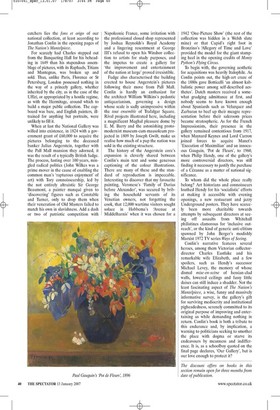How at last we got it together
Jonathan Keates THE NATION'S MANTELPIECE: A HISTORY OF THE NATIONAL GALLERY by Jonathan Conlin Pallas Athene, 42 Spencer Rise, London NW5 1AP, Tel: 0207 692 9984, £24.99, pp. 555, ISBN 1843680181 £19.99 (plus £2.45 p&p) 0870 429 6655 Stand in the Corinthian portico of the National Gallery's main building and look due south beyond Nelson's Column into Whitehall. Your gaze lights upon Hubert Le Sueur's Baroque equestrian statue of King Charles I, and if your eyesight is especially keen, you might just glimpse a projecting corner of Inigo Jones's Banqueting Hall. In this trio of eyecatchers lies the fons et origo of our national collection, at least according to Jonathan Conlin in the opening pages of The Nation's Mantelpiece.
For scarcely had Charles stepped out from the Banqueting Hall for his beheading in 1649 than his stupendous assemblage of pictures, with its Raphaels, Titians and Mantegnas, was broken up and sold. Thus, unlike Paris, Florence or St Petersburg, London possessed nothing in the way of a princely gallery, whether inherited by the city, as in the case of the Uffizi, or appropriated by a hostile regime, as with the Hermitage, around which to build a major public collection. The cupboard was bare, and English painters, illtrained for anything but portraits, were unlikely to fill it.
When at last the National Gallery was willed into existence, in 1824 with a government grant of £60,000 to acquire the pictures belonging to the deceased banker Julius Angerstein, together with the Pall Mall mansion they adorned, it was the result of a typically British fudge. The process, lasting over 100 years, mingled radical politics (John Wilkes was a prime mover in the cause of enabling the common man's 'rapturous enjoyment' of art) with Tory connoisseurship, led by the not entirely altruistic Sir George Beaumont, a painter manqué given to 'discovering' figures such as Constable and Turner, only to drop them when their veneration of Old Masters failed to match his own in slavishness. Add a dash or two of patriotic competition with Napoleonic France, some irritation with the professional closed shop represented by Joshua Reynolds's Royal Academy and a lingering resentment at George III's refusal to open his Windsor collection to artists for study purposes, and the impetus to create a gallery for 'the improvement and entertainment of the nation at large' proved irresistible.
Fudge also characterised the building erected to house Angerstein's pictures following their move from Pall Mall. Conlin is hardly an enthusiast for the architect William Wilkins's pedantic antiquarianism, governing a design whose scale is sadly unimpressive within the tout ensemble of Trafalgar Square. Rival projects illustrated here, including a magnificent Mughal pleasure dome by E. M. Barry and the astonishing protomodernist museum-cum-mausoleum projected in 1809 by Joseph Gwilt, make us realise how much of a pup the nation was sold in the existing structure.
The history of the Angerstein core's expansion is cleverly shared between Conlin's main text and some generous captioning of the colour illustrations. There are many of these and the standard of reproduction is impeccable. Interesting to discover that my favourite painting, Veronese's 'Family of Darius before Alexander', was secured by bribing the household servants of its Venetian owners, not forgetting the cook, that 12,000 wartime visitors sought solace in Hobbema's 'Avenue at Middelharnis' when it was chosen for a 1942 'One-Picture Show' (the rest of the collection was hidden in a Welsh slate mine) or that Cupid's right foot in Bronzino's 'Allegory of Time and Love' provided the model for the giant stamping heel in the opening credits of Monty Python's Flying Circus.
To begin with, the governing aesthetic for acquisitions was heavily Italophile. As Conlin points out, the high-art craze of the 1880s gave Botticelli 'an almost kabbalistic power among self-described aesthetes'. Dutch masters received a somewhat grudging admittance at first, and nobody seems to have known enough about Spaniards such as Velazquez and Zurbaran to beef up their meagre representation before their saleroom prices became stratospheric. As for the French Impressionists, their presence in the gallery remained contentious from 1917, when Maynard Keynes and Lord Curzon joined forces to acquire Manet's 'Execution of Maximilian' and an innocuous Gauguin, 'Pot de Fleurs', to 1960, when Philip Hendy, one of the gallery's more controversial directors, was still finding it necessary to justify the purchase of a Cezanne as a matter of national significance.
To whom did the whole place really belong? Art historians and connoisseurs loathed Hendy for his 'socialistic' efforts at making it accessible with evening openings, a new restaurant and jazzy Underground posters. They have scarcely been more charitable towards attempts by subsequent directors at seeing off assaults from Whitehall philistines clamorous for 'inclusive outreach', or the kind of generic anti-elitism spawned by John Berger's modishly Marxist 1972 TV series Ways of Seeing.
Conlin's narrative features several heroes, among them Victorian collectordirector Charles Eastlake and his remarkable wife Elizabeth, and a few spoilers, such as Hendy's successor Michael Levey, the memory of whose dismal mise-en-scene of hessian-clad walls, lowered ceilings and fussy little daises can still induce a shudder. Not the least fascinating aspect of The Nation's Mantelpiece, a wise, funny and massively informative survey, is the gallery's gift for surviving mediocrity and institutional pigheadedness, serenely committed to its original purpose of improving and entertaining us while demanding nothing in return. Conlin's book is both a tribute to this endurance and, by implication, a warning to politicians seeking to smother the place with dogma or starve its endeavours by meanness and indifference. It is, as a schoolboy quoted on the final page declares, 'Our Gallery', but is our love enough to protect it?























































 Previous page
Previous page